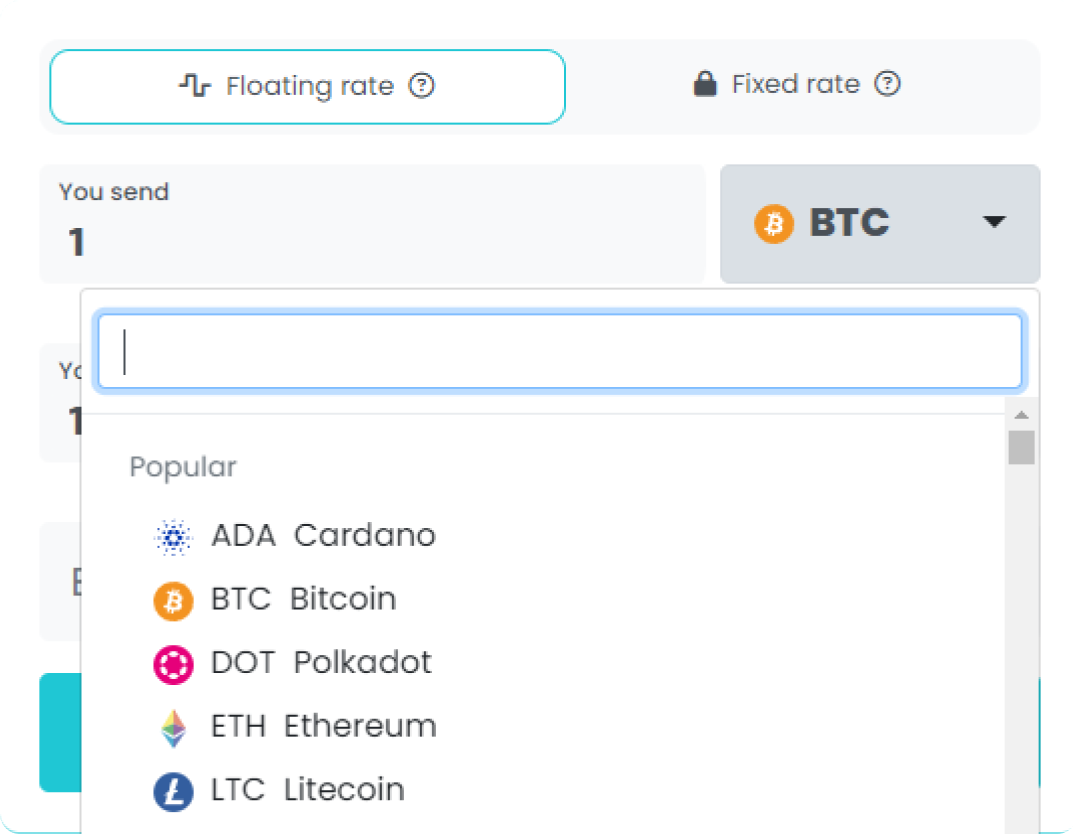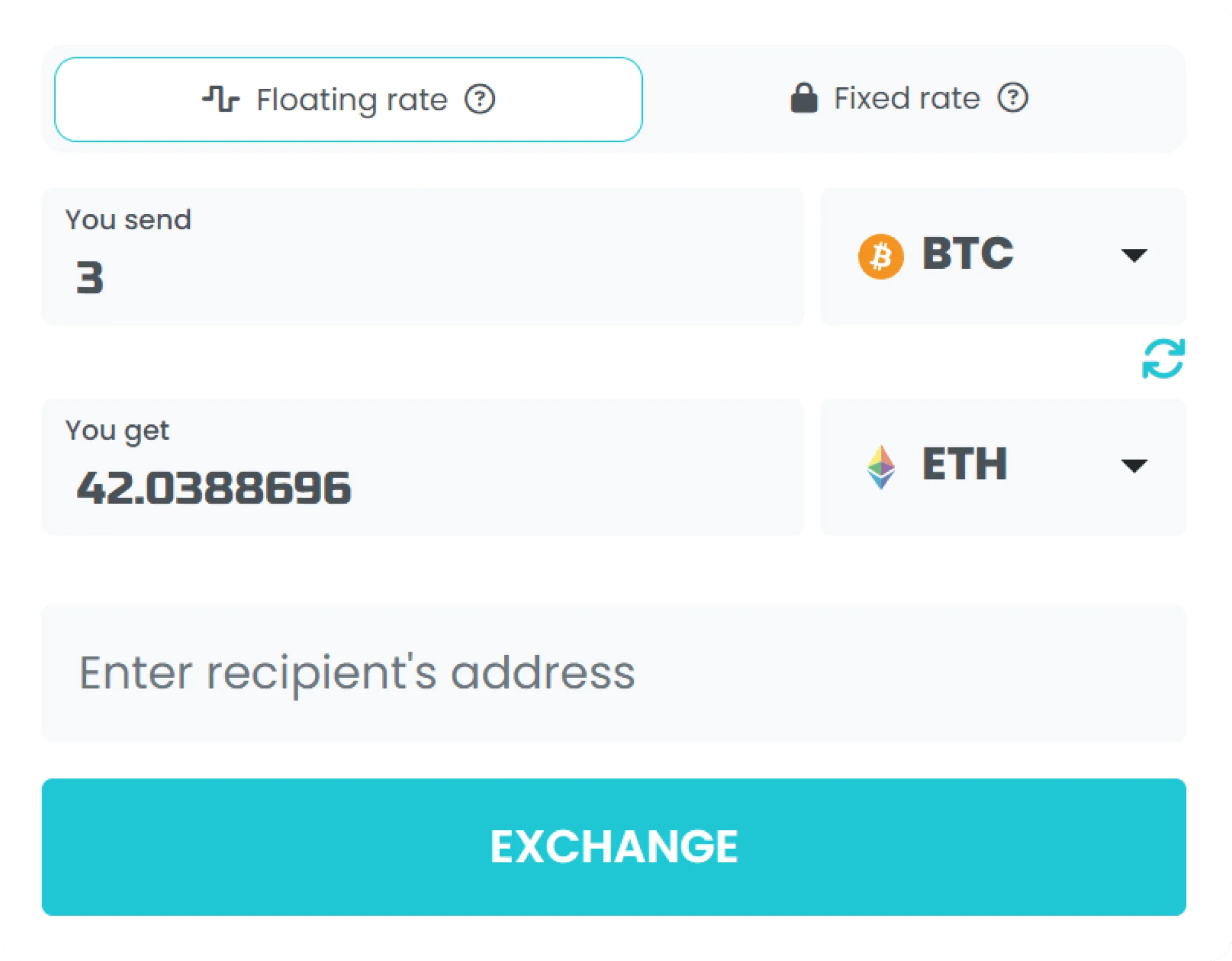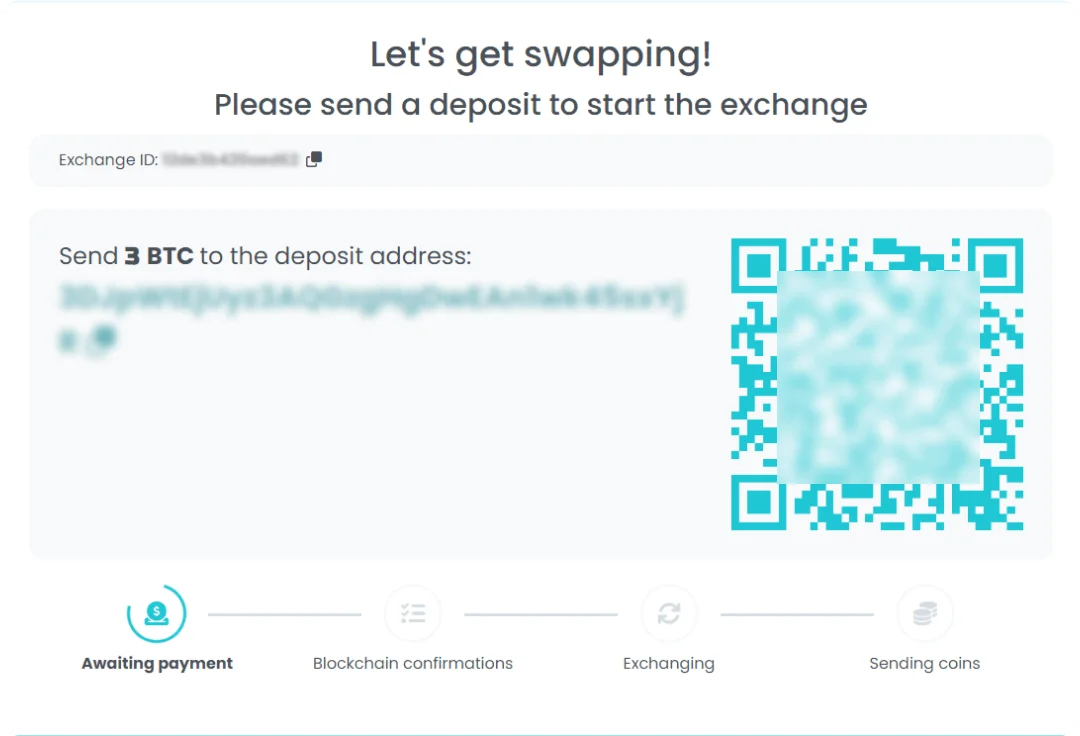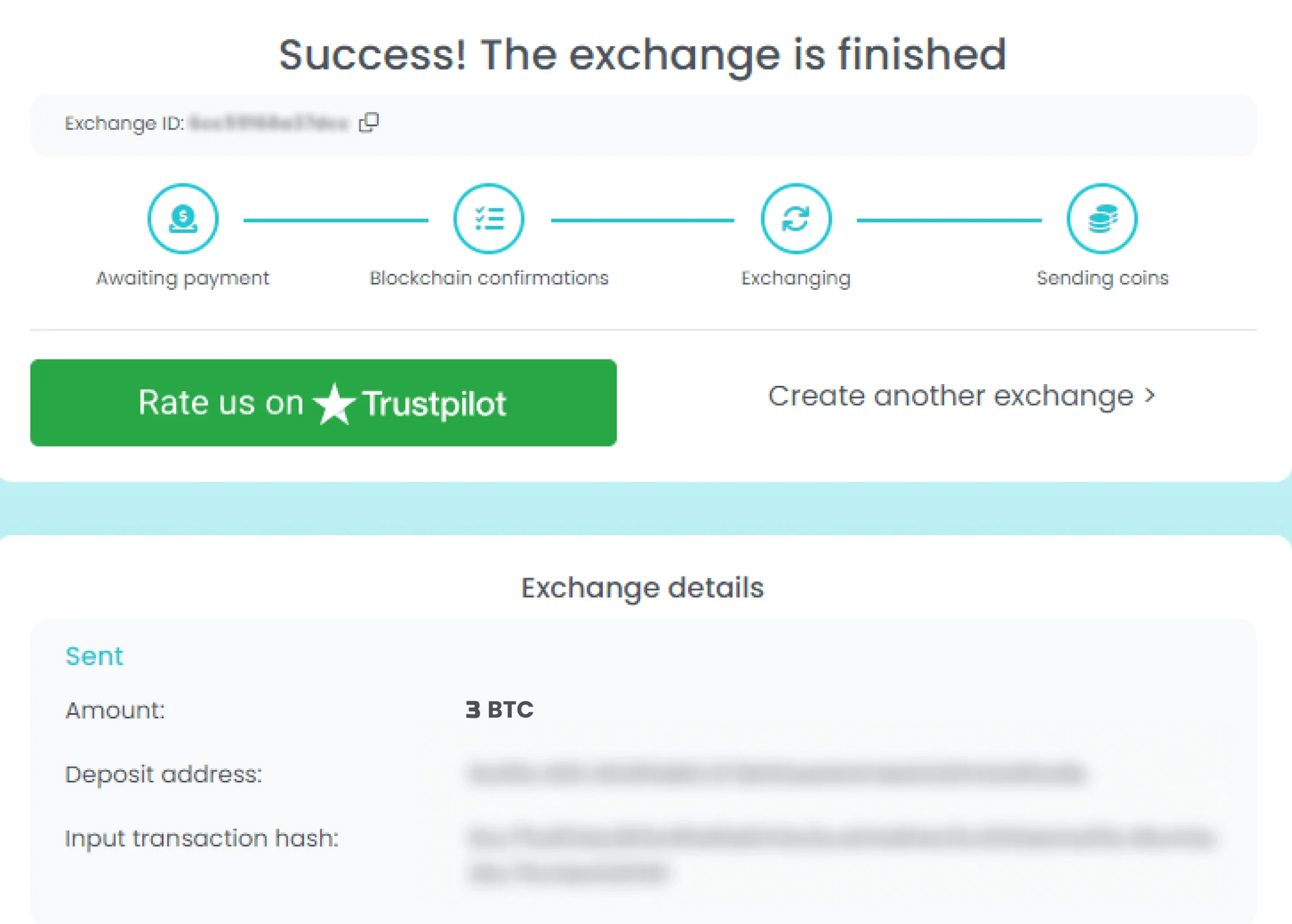How to Exchange EOS (EOS)
Exchange EOS instantly
Swap EOS (EOS) in a few clicks on Exchang.io.
Registration and limits free service.
Historical Price Chart
EOS Current Market Data
| Name | EOS |
|---|---|
| Price | $0.70 |
| Price Change 24h | -0.24% |
| Price Change 7d | -1.13% |
| Price Change 30d | -19.19% |
| Price Change 60d | 3.60% |
| Market Cap | $785,750,597.04 |
| Circulating Supply | 1,115,492,246.06 EOS |
| Volume 24h | $85,544,835.93 |
How to Exchange EOS in Just a Few Straightforward Steps
If you are looking to EOS exchange, you are in the right place. Swap EOS in a matter of minutes using Exchang.io crypto exchange. Just adhere to these 4 simple steps.




Benefits of Exchanging EOS on Exchang.io

Simple
We make sure not to overload our website with unnecessary elements. Only the things you need for smooth EOS conversions.Simple and clear.

Secure
Exchang.io is a safest place to exchange EOS. Get EOS anonymously, without KYC and registration.
In touch
Write to us in any unclear situation with EOS swaps. Our support team is happy to help you 24/7.
Fast
We are constantly upgrading our platform to make EOS exchanges really fast. The average speed for the swap is about 5-15 minutes.Popular EOS trading pairs
Here are some popular EOS trading pairs. You can buy EOS with every listed coin on Exchang.io.
How Much EOS Can I Exchange on Exchang.io?
Exchanging EOS on Exchang.io is unlimited. You can start swapping EOS right now starting from the lower limit of ≈ $3.
There are no upper limits for EOS exchanges at Exchang.io. Exchange EOS with other cryptocurrencies from the list of over 700 coins as much as you want to.
Cross-chain exchanges are available; just choose any coin on any network and click the Exchange button, and we'll do the rest for you
Why exchange EOS?
Things you will be able to do with exchanged EOS:
You can use EOS to pay for goods and services at merchants that accept this cryptocurrency as a form of payment. This includes online businesses, such as gaming platforms and e-commerce websites, as well as physical stores.
Another way to use EOS is by investing or trading it on cryptocurrency exchanges. You can buy EOS with other cryptocurrencies or fiat currencies, hold it as an investment, and sell it when its value increases.
With EOS, you can participate in the governance of the EOS blockchain ecosystem. As an EOS holder, you have the right to vote on important decisions related to the network's development and management.
Finally, EOS can also be used to access decentralized applications (dApps) built on the EOS blockchain. These dApps cover various fields, including social media, gaming, finance, and more. By using EOS to interact with these dApps, you can take advantage of their features and functionalities while maintaining control over your personal data and assets.
What is EOS?
EOS is a cryptocurrency that was launched in June 2018 by the company Block.one. The goal of EOS is to provide a scalable and flexible platform for decentralized applications, or dApps, that can handle millions of transactions per second.
EOS uses a delegated proof-of-stake (DPoS) consensus mechanism, which means that token holders vote on block producers who are responsible for maintaining the network and validating transactions.
One of the unique features of EOS is its governance model, which allows token holders to vote on proposed changes to the network's protocol. This gives users a greater say in the direction of the project and helps ensure that it remains decentralized.
In order to use EOS, developers must stake tokens as collateral to gain access to the network's resources, such as computing power and storage. This helps prevent spam and other malicious activity on the network.
EOS also has a built-in smart contract platform that allows developers to create and deploy their own dApps on the network. The platform supports programming languages such as C++ and Rust, making it accessible to a wide range of developers.
Another unique aspect of EOS is its transaction fee model. Unlike some other cryptocurrencies, EOS does not charge transaction fees. Instead, users must hold a certain amount of EOS in order to use the network's resources.
EOS has been criticized for its centralization, as a small number of block producers control a significant portion of the network's resources. However, proponents argue that this is necessary for scalability and performance.
Despite these criticisms, EOS has gained significant adoption in the dApp space. It is currently one of the most popular platforms for developing decentralized applications, with over 400 active projects and a market capitalization of over $3 billion.
The team behind EOS has also been working on improving the platform over time. In 2021, they launched a major upgrade called EOSIO 2.0, which introduced several new features such as faster transaction processing and improved security.
In addition to its use as a platform for dApps, EOS is also traded on cryptocurrency exchanges as a speculative asset. Like many cryptocurrencies, its price can be highly volatile and subject to market fluctuations.
EOS has also been involved in several high-profile controversies, including allegations of vote buying and collusion among block producers. These issues have raised questions about the integrity of the network's governance model.
Despite these challenges, EOS remains an important player in the crypto space. Its focus on scalability and usability has made it a popular choice for developers looking to create decentralized applications, and it continues to evolve and improve over time.
Brief History of EOS
EOS is a decentralized blockchain platform designed for building decentralized applications (dApps). It was launched in June 2018 by Block.one, a software company based in the Cayman Islands. The project was founded by Daniel Larimer, who is also the creator of the BitShares and Steem blockchain platforms.
The EOS mainnet launch was one of the most highly anticipated events in the cryptocurrency industry. The EOS token sale raised more than $4 billion over a year-long period, making it the largest initial coin offering (ICO) to date.
The EOS platform is designed to be fast, scalable, and user-friendly. It uses a delegated proof-of-stake (DPoS) consensus mechanism, which allows users to vote for block producers who validate transactions on the network.
One of the key features of EOS is its ability to support parallel processing of smart contracts, which makes it possible to handle a large number of transactions simultaneously. This is achieved through the use of inter-blockchain communication (IBC), which enables multiple EOS-based blockchains to communicate with each other.
Another important aspect of EOS is its governance system, which is designed to be community-driven. EOS token holders can vote on proposals related to the development and maintenance of the network, including decisions about block producer rewards, protocol upgrades, and budget allocations.
However, the EOS platform has faced criticism for its centralized nature, particularly with regard to block producer voting. Some critics have argued that the platform is vulnerable to collusion among block producers, as well as vote buying and other forms of manipulation.
In 2019, Block.one settled a lawsuit brought by the U.S. Securities and Exchange Commission (SEC) for conducting an unregistered securities offering during the EOS ICO. Block.one agreed to pay a $24 million fine without admitting guilt.
Despite these controversies, the EOS platform has continued to grow and evolve. In 2020, Block.one announced the launch of its EOSIO 2.0 protocol, which includes several new features and improvements designed to enhance performance and usability.
One of the most significant changes introduced in EOSIO 2.0 is the implementation of WebAuthn, a standard for cryptographic authentication that allows users to log in to dApps and other online services using biometric or hardware-based keys.
Another notable development on the EOS platform is the rise of decentralized finance (DeFi) applications. Several DeFi protocols have been built on EOS, including Equilibrium, which offers decentralized stablecoins and lending services, and Defibox, which provides automated market-making and liquidity provision.
In addition to DeFi, the EOS platform has also been used for gaming and social media applications. For example, the popular blockchain-based game Prospectors runs on the EOS network, as does the social media platform Voice, which aims to provide a more transparent and censorship-resistant alternative to traditional social networks.
Looking ahead, the future of EOS will depend on how well it can compete with other blockchain platforms that offer similar features and capabilities. Some potential challengers include Ethereum, which is currently the market leader in terms of decentralized application development, and newer platforms like Polkadot and Solana.
Nevertheless, EOS remains a significant player in the cryptocurrency industry, with a large and active community of developers and users. Its fast and scalable blockchain technology, combined with its user-friendly interface and governance model, make it a popular choice for building decentralized applications across a wide range of use cases.
EOS Key Advantages and Unique Features
The EOS cryptocurrency is a blockchain-based platform that was designed to enable decentralized applications (dApps) to be built and run on its network. It offers several significant advantages and unique features that set it apart from other cryptocurrencies.
One of the key advantages of EOS is its ability to process a high number of transactions per second, making it one of the most scalable blockchain platforms available. This is achieved through the use of a delegated proof-of-stake (DPoS) consensus mechanism, where users can vote for delegates who are responsible for validating transactions on the network. This allows EOS to achieve high levels of transaction throughput while maintaining a low level of latency.
Another unique feature of EOS is its governance system, which provides a framework for decision-making and dispute resolution on the platform. The system allows token holders to vote on proposals that affect the network, including changes to the protocol, upgrades, and funding requests. This provides a more democratic approach to decision-making compared to other blockchain projects.
The EOS platform also offers a flexible account management system, allowing developers to create custom rules and permissions for accounts. This allows dApp creators to design their own account structures, enabling them to tailor their application to specific use cases.
EOS has a unique resource model, with users renting network resources such as CPU and RAM instead of paying transaction fees. This provides a more predictable cost structure for users, with the ability to scale resources up or down depending on their needs.
The EOS network also supports inter-blockchain communication, enabling data to be transferred between different blockchains that support the same standard. This interoperability feature makes it possible for dApps to interact with each other, increasing the potential value of the EOS ecosystem.
Additionally, EOS offers a developer-friendly environment with a range of development tools and libraries, including its own programming language called EOSIO.CDT. This makes it easier for developers to build and deploy dApps on the platform, with a range of resources and support available from the EOS community.
The EOS platform has an emphasis on the user experience, with a focus on providing a seamless and efficient experience for both developers and users. This includes features such as instant finality, where transactions are confirmed within seconds, and intuitive interfaces for managing accounts and interacting with dApps.
EOS also supports smart contracts, which are self-executing contracts with the terms of the agreement between buyer and seller being directly written into lines of code. Smart contracts on EOS can be used to automate processes and provide trustless execution of agreements, making it easier to conduct business on the platform without the need for intermediaries.
One of the key advantages of EOS is its widespread adoption by a range of businesses and industries. This adoption has led to a growing ecosystem of dApps and services that are built on the platform, increasing its potential value proposition and utility for users.
Finally, EOS has a strong community of developers and supporters who are committed to the ongoing development and growth of the platform. This community provides a range of resources, including developer tools, educational materials, and support forums, making it easier for developers to build and deploy dApps on the network.
10 Facts About EOS
EOS is a decentralized cryptocurrency and blockchain platform that aims to provide high scalability, performance, and flexibility for developers to build decentralized applications (dApps).
The EOS mainnet was launched in June 2018 after a year-long initial coin offering (ICO) that raised over $4 billion, making it one of the largest ICOs in history.
EOS uses a delegated proof-of-stake (DPoS) consensus algorithm, which allows token holders to vote for block producers who validate transactions and create new blocks on the network.
The EOSIO software that powers the EOS blockchain is open source and maintained by Block.one, a blockchain technology company founded by Dan Larimer and Brendan Blumer.
One of the unique features of EOS is its "constitution," a set of rules and guidelines that govern the behavior of users and block producers on the network.
EOS has a maximum supply of 1 billion tokens, with a current circulating supply of around 950 million tokens.
EOS can be stored in any wallet that supports the ERC-20 standard, as EOS tokens were originally issued as ERC-20 tokens on the Ethereum blockchain before being swapped for native EOS tokens on the EOS mainnet.
While EOS is primarily used for building dApps on the EOS network, it can also be traded on many cryptocurrency exchanges and used as a means of payment and transfer.
Some notable dApps built on the EOS platform include Everipedia, a decentralized encyclopedia; Voice, a social media platform; and WAX, a decentralized marketplace for virtual goods.
Despite its popularity and potential, EOS has faced criticism for its centralized governance structure, technical issues, and concerns about the concentration of voting power among large token holders.
What is the Best Place to Exchange EOS?
Via Exchang.io service you can effortlessly swap EOS for over 700+ different assets. Begin by selecting EOS and your desired coin, paying attention to the network when making your choice. Next, provide the recipient's wallet address for the coin you're swapping to, and press 'Exchange' to continue. Deposit the required amount of EOS to the address displayed on the screen, ensuring you have the necessary amount to finalize the transaction. Once completed, check your wallet to confirm the arrival of your newly acquired coin. Exchang.io makes exchanging EOS simple and convenient, allowing you to enjoy a seamless experience with an extensive selection of coins to choose from.
Do I need an account to swap EOS on Exchang.io?
No, you don't need to create an account or provide personal information to swap EOS on Exchang.io. The platform is registration-free and doesn't require any ID verification. Just follow the simple steps and exchange EOS with your crypto.
How long does it take to exchange EOS on Exchang.io?
The exchange process on Exchang.io is fast and typically takes only a few minutes to complete. However, the actual time may vary slightly depending on network traffic and transaction confirmation times.
What is the minimum amount required to swap EOS on Exchang.io?
There is a minimum amount required for EOS exchange on Exchang.io, but this may change periodically. It's recommended to check the platform for the latest requirements.
Is Exchang.io trustworthy? Why should I trust them?
Exchang.io is made up of crypto enthusiasts with over 7 years of experience in the cryptocurrency industry. The platform's main goal is to provide a convenient, transparent, and fast service for users. To improve their services, they closely monitor feedback from the community on social media channels. You can check reviews on Exchang.io to see what other users have to say about the platform.
What are some popular EOS trading pairs on Exchang.io?
Popular EOS trading pairs on Exchang.io include EOS/BTC, EOS/ETH, EOS/LTC, and EOS/USDT, among others.
Does Exchang.io support cross-chain exchanges for EOS?
Yes, Exchang.io supports cross-chain exchanges for EOS. You can choose any coin on any network, click the 'Exchange' button, and Exchang.io will handle the rest.
